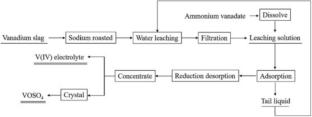Preparation of vanadium flow battery electrolytes: in-depth analysis and prospects of multifaceted approaches
Abstract
The preparation technology for vanadium flow battery (VRFB) electrolytes directly impacts their energy storage performance and economic viability. This review analyzes mainstream methods: The direct dissolution method offers a simple process but suffers from low dissolution rates, precipitation tendencies, and requires optimization of reductants and enhancement techniques. The electrolytic reduction method enables precise control over vanadium ion valence states but faces challenges such as high energy consumption and complex equipment. The solvent extraction method efficiently separates vanadium from impurities but involves lengthy procedures and emulsification risks. The ion exchange method is suitable for low-concentration purification but is constrained by limited resin capacity and wastewater treatment difficulties. Future efforts should focus on developing short-process technologies based on vanadium leaching solutions, overcoming bottlenecks in impurity separation and concentration enhancement, and advancing large-scale production of low-cost, high-stability electrolytes to accelerate VRFB applications in energy storage systems.


 求助内容:
求助内容: 应助结果提醒方式:
应助结果提醒方式:


